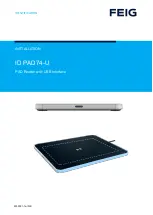
C–2
Printing PDF417 Labels
The error correction level is selectable. Choose the level depending on the expected
amount of label damage. Higher levels can compensate for higher amounts of label
damage, but every increase in error correction level doubles the amount of error
correction codewords needed. The damage may be located anywhere in the label as long
as the total area damaged is less than the total area filled by error correction codewords.
Since the amount of damage is typically proportional to the size of the label, choose the
number or error correction codewords to be proportional to the number of message
codewords. Welch Allyn recommends adding an extra 15–25% codewords for error
correction. If little or no damage is expected, try 10%. If more damage is expected, use
30%.
C.3
Improving Readability
Printing parameters strongly affect the label’s readability. When chosen carefully,
printing parameters can make scanning easy. Readability can be measured by:
1.
Tilt angle
2.
Scan speed
3.
Tolerance to label damage
C.3.1
Tilt Angle
When reading PDF417 labels, the scanner first reassembles the codeword matrix in
memory. Bar code scanners are good at interpreting patterns of bars and spaces. When
reading PDF417 labels, the scanner has the added task of being able to locate each
codeword in the matrix. This task is easiest when the scan line is parallel to the rows of
codewords. PDF417 has been designed to allow a small amount of tilt.
Welch Allyn PDF417 capable products have been designed to perform well even at high
tilt angles. The absolute maximum angle is determined by the X and Y dimensions. At
least two codewords must be captured in a single row.
C.3.2
Scan Speed
As the scanner passes over the PDF417 label, codewords are interpreted and stored into
memory. For excellent readability, the scanner should capture every row at least once as
it passes over the label. The taller the row height, the faster the scanner can pass over the
label. A scan captured at or near the edge between two rows will be hampered by
reflectance from the neighboring row (inter–row interference).
Summary of Contents for Scanteam 3700PDF
Page 1: ...PDF417 Capable CCD Reader ...
Page 2: ... 1998 Welch Allyn Inc All rights reserved ...
Page 5: ......
Page 15: ...1 4 SCANTEAM 3700PDF Description ...
Page 71: ...D 2 ASCII Conversion Table ...
Page 77: ...Glossary 6 ...
Page 81: ...Index 4 ...
















































